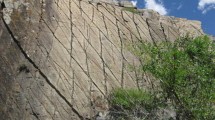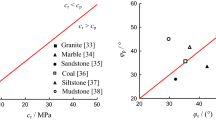Summary
This paper investigates the processes of joint surface damage and near-surface intact rock tensile failure using a hybrid FEM/DEM code. Selected Barton and Choubey JRC profiles were simulated in direct shear tests and the surface damage mechanisms investigated in terms of joint surface wear or tensile fracturing of intact rock along the joint plane. Shear strength and displacement profiles for each joint profile are numerically simulated. Numerical results agree closely with published experimental observations. Furthermore, results show that dilation along the joint is controlled dominantly by the joint surface geometry and the applied normal stress. Significant dilation is expected to occur where there is a large asperity provided the applied normal stress is low. In this case, joint surface damage is limited to surface wear. In contrast, when the applied normal stress is high, dilation will be low and damage is composed of both surface wear and asperity breakage through near-joint-surface intact rock tensile failure. Local joint dilation angles vary in proportion to the magnitude of the dilation. Several joint profiles with different geometrical configurations were simulated within a slope and the possible modes of joint surface damage were investigated. It was found that due to low normal stresses acting on the joint surfaces within a slope the dominant mode of joint surface damage is by yielding and surface wear of asperities.
Similar content being viewed by others
References
S. C. Bandis A. C. Lumsden N. Barton (1981) ArticleTitleExperimental studies of scale effects on the shear behaviour of rock joints Int. J. Rock Mech. Min. Sci. Geomech. Abstr. 18 1–21 Occurrence Handle10.1016/0148-9062(81)90262-X
S. C. Bandis A. C. Lumsden N. Barton (1983) ArticleTitleFundamentals of rock joint deformation Int. J. Rock Mech. Min. Sci. Geomech. Abstr. 20 IssueID6 249–268 Occurrence Handle10.1016/0148-9062(83)90595-8
Bandis, S. C., Barton, N., Christianson, M. (1985): Application of a new numerical model of joint behavior to rock mechanics problems. Proc. of the Int. Symp. on Fundamental of Rock Joints, Sweden, 15–20 September 1985, 345–355.
Barton, N. (1971): A model study of the behavior of steep excavated rock slopes. Thesis, Univ. London, 376.
N. Barton (1973) ArticleTitleReview of a new shear-strength criterion for rock joints Eng. Geol. 7 IssueID4 287–332 Occurrence Handle10.1016/0013-7952(73)90013-6
N. Barton V. Choubey (1977) ArticleTitleThe shear strength of rock joints in theory and practice Rock Mech. 10 1–54 Occurrence Handle10.1007/BF01261801
Barton, N., Bandis, S. C. (1982): Effects of block size on the shear behavior of jointed rock. Keynote Lecture, 23rd U.S. Symp. on Rock Mech., Berkeley, California, 739–760.
N. Barton S. C. Bandis K. Bakhtar (1985) ArticleTitleStrength, deformation and conductivity coupling of rock joints Int. J. Rock Mech. Min. Sci. Geomech. Abstr. 22 IssueID3 121–140 Occurrence Handle10.1016/0148-9062(85)93227-9
A. J. Beer D. Stead J. Coggan (2002) ArticleTitleA critical assessment of discontinuity roughness characterization J. Rock Mech. Rock Eng. 35 65–74 Occurrence Handle10.1007/s006030200009
M. V. Berry Z. V. Lewis (1980) ArticleTitleOn the Weierstrass–Mandelbrot fractal function Royal Society of London. Proc. Ser. A. 370 459–484 Occurrence Handle10.1098/rspa.1980.0044
Brady, B. H. G., Brown, E. T. (2004): Rock mechanics of underground mining, 4th edn., 588.
Coggan, J., Pine, R. J., Stead, D., Rance, J. (2003): Numerical modeling of brittle rock failure using a combined finite-discrete element approach: implications for rock engineering design, ISRM 2003-Technology roadmap for rock mechanics. South African Institute of Mining and Metallurgy, 5.
Coulson, J. H. (1970): The effect of surface roughness on the shear strength of joints in rock. Thesis. Univ. Illinois. U.S. Dept. Army Corps. Eng. Miss. River Div., Omaha, Nebr., Tech. Rep MRD-2-70, 283.
T. Crook S. Willson J. G. Yu R. Owen (2003) ArticleTitleComputational modeling of the localized deformation associated with borehole breakout in quasi-brittle materials J. Petroleum Sci. Eng. 38 177–186 Occurrence Handle10.1016/S0920-4105(03)00031-7
Cundall, P., Marti, J., Beresford, J., Last, P., Asagian, M. (1978): Computer modeling of jointed rock masses. Report prepared for the U.S. Army Corp. of Engineers, Waterways, Experimental Station by Dames and More, 396.
Cundall, P., Lemos, J. V. (1988): Numerical simulation of fault instabilities with a continuously-yielding joint model. In: Fairhurst, C. (ed.), Proc. of the 2nd Int. Symp. on Rockbursts and Seismicity in Mines. Minneapolis, 8–10 June 1988, 147–152.
C. H. Dowding A. Zubelewicz K. O’Connor T. B. Belytschko (1989) ArticleTitleExplicit modeling of dilation, asperity degradation and cyclic seating of rock joints Comput. Geotech. 11 IssueID3 209–227 Occurrence Handle10.1016/0266-352X(91)90020-G
Drozd, K. (1967): Variations in the shear strength of a rock mass depending on the displacements of the test blocks. Proc. Geotechnical Conference on Shear Strength Properties of Natural Soils and Rock, Oslo 1, 265–269.
Eberhardt, E., Stead, D., Karami, A., Coggan, J. (2004): Numerical analysis of brittle fracture propagation and step-path failure in massive rock slopes. Annual Canadian Geotechnical Conference, Quebec City, 665–672.
J. Feder (1988) Fractals Plenum Press New York 283
G. Grasselli (2006) ArticleTitleShear strength of rock joints based on quantified surface description Rock Mech. Rock Eng. 39 IssueID4 295–314 Occurrence Handle10.1007/s00603-006-0100-0
Grasselli, G., Egger, P. (2000): Shear strength equation for rock joints, based on 3d surface characterization. Proc. GeoEng. 2000, vol. 2, Melbourne, Australia, Technomic P.C. Inc.: Lancaster, 88.
HCItasca (2004): UDEC version 4.0, User’s Manual, Itasca Consulting Group Inc. Minneapolis, MN.
X. Huang B. C. Haimson M. Plesha X. Qiu (1993) ArticleTitleAn investigation of the mechanics of rock joints – part I. Laboratory investigation Int. J. Rock Mech. Min. Sci. Geomech. Abstr. 30 IssueID3 257–269 Occurrence Handle10.1016/0148-9062(93)92729-A
R. W. Hutson C. H. Dowding (1990) ArticleTitleJoint asperity degradation during cyclic shear Int. J. Rock Mech. Min. Sci. Geomech. Abstr. 27 IssueID2 109–119 Occurrence Handle10.1016/0148-9062(90)94859-R
Indraratna, B., Haque, A. (2000): Shear behavior of rock joints, A. A. Balkema, 164.
Klerck, P. (2000): The finite element modeling of discrete fracture in quasi-brittle materials. Ph.D. Thesis, University of Wales, Swansea.
Klerck, P. (2004): In: Sellers, E. J., Owen, D. R. J. (eds.), Discrete fracture in discrete-brittle materials under compressive and tensile stress states. Comput. Methods Appl. Mech. Engrg. 193, 3035–3056.
P. H. S. W. Kulatilake G. Shou T. H. Huang R. M. Morgan (1995) ArticleTitleNew peak shear strength criterion for anisotropic rock joints Int. J. Rock Mech. Min. Sci. Geomech. Abstr. 32 IssueID7 673–697 Occurrence Handle10.1016/0148-9062(95)00022-9
Kulatilake, P. H. S. W., Um, J., Panda, B. B., Nghiem, N. (1998): Development of a new peak shear strength criterion for anisotropic rock joints. Int. J. Rock Mech. Min. Sci. 35(4–5), Paper No. 040.
P. H. S. W. Kulatilake J. Um (1999) ArticleTitleRequirements for accurate quantification of self-affine roughness using the roughness-length method Int. J. Rock Mech. Min. Sci. 36 5–18 Occurrence Handle10.1016/S0148-9062(98)00170-3
P. H. S. W. Kulatilake P. Balasingham J. Park R. Morgan (2006) ArticleTitleNatural rock joint roughness quantification through fractal technique Geotech. Geol. Eng. 24 1181–1202 Occurrence Handle10.1007/s10706-005-1219-6
Ladanyi, B., Archambault, G. (1969): Simulation of shear behavior of a jointed rock mass. Proc. of the Symposium on Rock Mechanics, “Rock Mechanics – Theory and Practice”, Chapter 7, Berkeley, CA, 105–125.
H. S. Lee Y. J. Park T. F. Cho K. H. You (2001) ArticleTitleInfluence of asperity degradation on the mechanical behavior of rough joints under cyclic shear loading Int. J. Rock Mech. Min. Sci. 38 967–980 Occurrence Handle10.1016/S1365-1609(01)00060-0
Y. H. Lee J. R. Carr D. J. Barr C. J. Haas (1990) ArticleTitleThe Fractal dimension as a measure of the roughness of rock discontinuity profiles Int. J. Rock Mech. Min. Sci. Geomech. Abstr. 27 IssueID6 453–464 Occurrence Handle10.1016/0148-9062(90)90998-H
Lessard, J. S., Hadjigeorgiou, J. (1998): Quantifying joint roughness using artificial neural networks. Int. J. Rock Mech. Min. Sci. 35(4–5), Paper No. 093.
A. Malinverno (1990) ArticleTitleA simple method to estimate the fractal dimension of a self affine series Geophys. Res. Lett. 17 IssueID11 1953–1956 Occurrence Handle10.1029/GL017i011p01953
Matsushita, M., Ouchi, S. (1989): In: Physica, D. (ed.), On the self affinity of various curves, vol. 38, 246–251.
B. B. Mandelbrot (1983) The fractal geometry of nature Freeman San Francisco
Munjiza, A. (1992): Discrete elements in transient dynamics of fractured media. Ph.D. Thesis, Department of Civil Engineering, University of Wales, Swansea.
A. Munjiza N. Owen A. Bicanic (1995) ArticleTitleA combined finite-discrete element method in transient dynamics of fracturing solids Eng. Comput. 12 145–174 Occurrence Handle10.1108/02644409510799532
O’Connor, K., Zubelewicz, A., Dowding, C. H., Belytschko, T. B., Plesha, M. (1986): Cavern response to earthquake shaking with and without dilation. Proc. 27th U.S. Symp. on Rock Mechanics, University of Alabama, 891–895.
S. Orey (1970) ArticleTitleGaussian simple functions and Hausdorff dimension of level crossings Z. Wahrscheinlichkeitstheor. verw. Gebiete 15 249–256 Occurrence Handle10.1007/BF00534922
Patton, F. D. (1966): Multiple modes of shear failure in rock. Proc. 1st Congress of Int. Soc. Rock Mech., Lisbon, 1, 509–513.
M. Plesha (1987) ArticleTitleConstitutive models for rock discontinuities with dilatancy and surface degradation Int. J. Numer. Analyt. Meth. Geomech. 11 345–362 Occurrence Handle10.1002/nag.1610110404
Rockfield Software (2004): ELFEN version 3.1, User’s Manual. Swansea, U.K.
Schrauf, T. W. (1984): Relationship between the gas conductivity and water geometry of a natural fracture. M.Sc. Thesis, Dept. of Hydrology and Water Resources, University of Arizona, 156.
J. P. Seidel C. M. Haberfield (1995) ArticleTitleThe application of energy principles to the determination of the sliding resistance of rock joints Rock Mech. Rock Eng. 28 IssueID4 211–226 Occurrence Handle10.1007/BF01020227
E. J. Sellers P. Klerck (2000) ArticleTitleModeling of the effect of discontinuities on the extent of the fracture zone surrounding deep tunnels Tunn. Undergr. Sp. Tech. 15 IssueID4 463–469 Occurrence Handle10.1016/S0886-7798(01)00015-3
A. P. S. Selvadurai Q. Yu (2005) ArticleTitleMechanics of a discontinuity in a geomaterial Comput. Geotech. 32 92–106
D. Stead J. Coggan (2006) Numerical modeling of rock slopes using a total slope failure approach S. Evans R. Hermanns A. Strom (Eds) Landslide from massive rock slope failure Springer Dordrecht, Netherlands 131–142
D. Stead E. Eberhardt J. Coggan (2006) ArticleTitleDevelopments in the characterization of complex rock slope deformations and failure using numerical modeling techniques Eng. Geol. 83 IssueID1 217–235 Occurrence Handle10.1016/j.enggeo.2005.06.033
R. Tse D. M. Cruden (1979) ArticleTitleEstimating joint roughness coefficients Int. J. Rock Mech. Min. Sci. Geomech. Abstr. 16 303–307 Occurrence Handle10.1016/0148-9062(79)90241-9
Turk, N. (1987): Characterization of rock joint surfaces by fractal dimension. Proc. of the 28th U.S. Symp. of Rock Mechanics, Tucson, 29 June–1 July 1987, 1223–1236.
Turk, N., Dearman, W. R. (1985): Investigation of some rock joint properties: Roughness angle determination and joint closure. Proc. of the Int. Symp. on Fundamentals of Rock Joints. Bjorkliden, 15–20 September 1985, 197–204.
Unal, M., Unver, B. (2004): Characterization of rock joint surface degradation under shear loads. Int. J. Rock Mech. Min. Sci. 41(3), CD-ROM.
X. Yu B. Vayssade (1991) ArticleTitleJoint profiles and their roughness parameters, Technical note Int. J. Rock Mech. Min. Sci. Geomech. Abstr. 28 IssueID4 333–336 Occurrence Handle10.1016/0148-9062(91)90598-G
Zubellewicz, A., O’Connor, K., Dowding, C. H., Belytschko, T. B., Plesha, M. (1987): A constitutive model for the cyclic behavior of dilatant rock joints. In: Desai, C. S. (ed.), Proc. 2nd Int. Conf. on Constitutive Laws for Engineering Materials: Theory and Application, Tucson, Arizona, 1137–1144.
Author information
Authors and Affiliations
Additional information
Authors’ address: Amir Karami, Golder Associates Ltd., 4260 Still Creek Drive, Suite 500, Burnaby, Vancouver, British Columbia, BC V5C 6C6 Canada
Rights and permissions
About this article
Cite this article
Karami, A., Stead, D. Asperity Degradation and Damage in the Direct Shear Test: A Hybrid FEM/DEM Approach. Rock Mech Rock Eng 41, 229–266 (2008). https://doi.org/10.1007/s00603-007-0139-6
Received:
Accepted:
Published:
Issue Date:
DOI: https://doi.org/10.1007/s00603-007-0139-6




